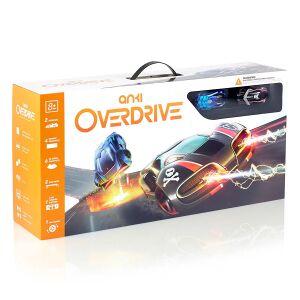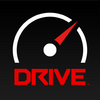Overdrive: Difference between revisions
m digital dream link |
m Add Category |
||
| (3 intermediate revisions by 2 users not shown) | |||
| Line 1: | Line 1: | ||
[[File:Anki Overdrive Box.jpg|thumb|Anki Overdrive Box]] | |||
== Introduction == | == Introduction == | ||
Anki Overdrive is an advanced battle-racing system developed by Anki, an American robotics and artificial intelligence startup, and later acquired by Digital Dream Labs in December 2019. Released on September 20, 2015, as the successor to [[Drive|Anki Drive]], Overdrive introduced modular tracks, enhanced artificial intelligence (A.I.), and customizable gameplay, earning recognition as a pioneering blend of physical toys and video game mechanics. Marketed as “the world’s most intelligent battle racing system,” it combines robotic supercars with a mobile app to deliver dynamic racing and combat experiences for players of all ages. Overdrive released on December 17th, 2015 | Anki Overdrive is an advanced battle-racing system developed by Anki, an American robotics and artificial intelligence startup, and later acquired by Digital Dream Labs in December 2019. Released on September 20, 2015, as the successor to [[Drive|Anki Drive]], Overdrive introduced modular tracks, enhanced artificial intelligence (A.I.), and customizable gameplay, earning recognition as a pioneering blend of physical toys and video game mechanics. Marketed as “the world’s most intelligent battle racing system,” it combines robotic supercars with a mobile app to deliver dynamic racing and combat experiences for players of all ages. Overdrive released on December 17th, 2015 | ||
| Line 40: | Line 42: | ||
== Version History == | == Version History == | ||
[[File:Anki Drive App Icon.webp|thumb|100x100px|Anki Drive Icon]] | |||
==== [[Drive|Anki Drive]] (2013) ==== | ==== [[Drive|Anki Drive]] (2013) ==== | ||
* Standalone racing system using fixed vinyl track mats. Cars featured basic AI and optical sensors, with no modular track configuration. | * Standalone racing system using fixed vinyl track mats. Cars featured basic AI and optical sensors, with no modular track configuration.[[File:Anki Overdrive 1.png|thumb|100x100px|Anki Overdrive v1-v3 icon]] | ||
==== Overdrive v1 (September 20, 2015) ==== | ==== Overdrive v1 (September 20, 2015) ==== | ||
| Line 59: | Line 62: | ||
==== Overdrive v3.4 (Final Anki Release) ==== | ==== Overdrive v3.4 (Final Anki Release) ==== | ||
* Last official Anki update. Menu design was refreshed, but some single-player content was reduced. Performance and balance issues persisted in certain configurations. | * Last official Anki update. Menu design was refreshed, but some single-player content was reduced. Performance and balance issues persisted in certain configurations.[[File:Anki Overdrive F&F.jpg|thumb|100x100px|Anki Overdrive Fast and Furious icon]] | ||
==== Fast & Furious Edition (v3.4) ==== | ==== Fast & Furious Edition (v3.4) ==== | ||
* Themed variant featuring licensed vehicles and custom audio. Gameplay mechanics mirrored v3.4, with additional track elements such as the Power Zone. | * Themed variant featuring licensed vehicles and custom audio. Gameplay mechanics mirrored v3.4, with additional track elements such as the Power Zone. | ||
==== [[Digital Dream Labs|DDL]] Relaunch (v2.6) ==== | ==== [[Digital Dream Labs|DDL]] Relaunch (v2.6) ==== | ||
| Line 69: | Line 73: | ||
* DDL’s revival of the v2.6 codebase with bug fixes. | * DDL’s revival of the v2.6 codebase with bug fixes. | ||
[[File:Overdrive 2.6.webp|thumb|100x100px|Overdrive 2.6 Relaunch Icon]] | |||
==== Overdrive 4.0 ==== | ==== Overdrive 4.0 ==== | ||
* Complete app rewrite by lrdsnow, parts of the codebase are open source [https://github.com/lrdsnow on their GitHub] | * Complete app rewrite by lrdsnow, parts of the codebase are open source [https://github.com/lrdsnow on their GitHub] | ||
[[File:Overdrive v4.webp|thumb|100x100px|Overdrive V4 icon]] | |||
* Was released for 1 week then was taken down due to bugs occurring during the app's beta stage. | * Was released for 1 week then was taken down due to bugs occurring during the app's beta stage. | ||
| Line 80: | Line 85: | ||
== Hardware == | == Hardware == | ||
[[File:Overdrive insides.webp|thumb|Supercar insides]] | |||
* '''Microcontroller (SoC)''': STM32F051K8 (ARM Cortex-M0, 48 MHz) handles core control and sensor integration. | * '''Microcontroller (SoC)''': STM32F051K8 (ARM Cortex-M0, 48 MHz) handles core control and sensor integration. | ||
| Line 98: | Line 103: | ||
* '''SD Logging''': High-speed telemetry (up to 500 Hz) to installed microSD card modules for debugging advanced behaviors. | * '''SD Logging''': High-speed telemetry (up to 500 Hz) to installed microSD card modules for debugging advanced behaviors. | ||
[[Category:Overdrive]] | |||
Latest revision as of 06:41, 17 June 2025

Introduction
Anki Overdrive is an advanced battle-racing system developed by Anki, an American robotics and artificial intelligence startup, and later acquired by Digital Dream Labs in December 2019. Released on September 20, 2015, as the successor to Anki Drive, Overdrive introduced modular tracks, enhanced artificial intelligence (A.I.), and customizable gameplay, earning recognition as a pioneering blend of physical toys and video game mechanics. Marketed as “the world’s most intelligent battle racing system,” it combines robotic supercars with a mobile app to deliver dynamic racing and combat experiences for players of all ages. Overdrive released on December 17th, 2015
Overview
Anki Overdrive features robotic supercars equipped with optical sensors, wireless chips, motors, and powerful A.I. software, enabling them to navigate tracks autonomously, learn layouts, and adapt to player strategies. The system is controlled via a mobile app available for iOS and Android, which supports cross-platform multiplayer battles for up to four players. The modular track system, composed of magnetic, durable pieces, allows users to construct over eight unique layouts with the starter kit, expandable with additional pieces like jumps, banked corners, and crossings. The supercars, designed with input from Harald Belker (known for Tron Legacy and Batman & Robin), feature distinct personalities, driving styles, and upgradable weapons such as plasma cannons, flame throwers, and grappling hooks.
Gameplay
Anki Overdrive offers multiple game modes, including:
- Race: A traditional 15-lap competition to finish first.
- Battle: Players use virtual weapons to disable opponents while racing.
- King of the Hill: Players aim to hold the “king” position for 60 seconds by avoiding attacks.
- Time Trial: A solo mode to achieve the fastest lap times.
- Campaign: A single-player mode with 81 quests across three difficulty levels.
The A.I.-driven supercars improve with player performance, adapting tactics and increasing difficulty. Players can customize cars with weapon upgrades and modifiers like “Balance Cars” (equalizing stats) or “One Shot” (instant-disable shots). The app provides immersive audio and voiceovers, ensuring long-term engagement.
Components
The Anki Overdrive Starter Kit includes:
- Two supercars (e.g., Skull and GroundShock).
- Ten track pieces (four straight, six curved).
- Two riser pieces for elevation.
- A charging platform (full charge in 8–10 minutes).
Expansion packs offer additional cars (e.g., Thermo, Nuke, Guardian), supertrucks with exclusive game modes, and track kits like the Launch Kit for jumps or Speed Kit for straightaways. The Fast & Furious Edition (2017) introduced themed vehicles (e.g., Dom’s Ice Charger) and a Power Zone track piece, retailing at $169.99, a $20 premium over the standard kit.
Development and Release
Founded in 2010 by Boris Sofman, Mark Palatucci, and Hanns Tappeiner, Anki debuted Anki Drive in 2013, showcasing its robotics expertise at Apple’s WWDC keynote. Overdrive addressed Drive’s limitations, replacing fixed vinyl mats with modular tracks and enhancing A.I. capabilities. The system launched at $149.99, with expansion cars at $49.99 and track packs from $9.99 to $29.99.
Reception
Anki Overdrive was praised for its innovative fusion of physical and digital play, earning accolades for its intuitive setup, durable tracks, and engaging A.I. Trusted Reviews called it “mechanical racing at its best,” while VentureBeat highlighted its “well-judged fusion of real and virtual.” Critics noted its high cost, with expansions adding to expenses, and some reported issues with cars derailing on jumps. The Fast & Furious Edition was lauded for its value, especially for film fans, though character-specific gameplay was limited.
Version History

Anki Drive (2013)
- Standalone racing system using fixed vinyl track mats. Cars featured basic AI and optical sensors, with no modular track configuration.

Anki Overdrive v1-v3 icon
Overdrive v1 (September 20, 2015)
- Introduced magnetic track modules, weapon loadouts, and AI that learned track layouts and opponent behavior.
Overdrive v2.6 (December 17, 2015)
- Widely regarded as the definitive release. Features included a single-player tournament mode, balanced weapon and power-up mechanics, and a polished user interface. Later patched to v2.6.10 to expand compatibility across all vehicles.
Overdrive v2.8
- Transitioned from tournament mode to a streamlined campaign structure. Multiplayer balance adjustments received mixed community feedback.
Overdrive v3.4 (Final Anki Release)
- Last official Anki update. Menu design was refreshed, but some single-player content was reduced. Performance and balance issues persisted in certain configurations.

Anki Overdrive Fast and Furious icon
Fast & Furious Edition (v3.4)
- Themed variant featuring licensed vehicles and custom audio. Gameplay mechanics mirrored v3.4, with additional track elements such as the Power Zone.
DDL Relaunch (v2.6)
- DDL’s revival of the v2.6 codebase with bug fixes.

Overdrive 4.0
- Complete app rewrite by lrdsnow, parts of the codebase are open source on their GitHub

- Was released for 1 week then was taken down due to bugs occurring during the app's beta stage.
Overdrive 5.0
- Marketed as a new major release but functionally a retread of v2.6 with omissions (notably Fast & Furious content). Android editions employ patched bytecode for compatibility with recent OS versions; iOS editions derive from intermediate builds with developer features removed. Community consensus views it as a versioning artifact rather than a true update.
Hardware

- Microcontroller (SoC): STM32F051K8 (ARM Cortex-M0, 48 MHz) handles core control and sensor integration.
- Optical Sensor: OmniVision OV7739 grayscale camera module for track-line detection and car positioning.
- Drive Motors: Brushed DC motors; optimized gearing for torque at low speeds.
- Communication: Bluetooth 4.0; ~18ms per packet delay with the original Overdrive app, ~2-4ms per packet delay with Overdrive 4.0.
Debug and Firmware Tools
- SWD Interface: Secure debug port (locked on production hardware).
- UART Logging: Serial output available via a dedicated header for firmware diagnostics.
- ChargeFlash: Flashing method using the car’s charging contacts and standard USB-to-TTL UART adapters; the primary reflash mechanism supported on production hardware. ChargeLink can also be used for ChargeFlash.
- SD Logging: High-speed telemetry (up to 500 Hz) to installed microSD card modules for debugging advanced behaviors.